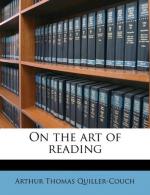Now hear Bacon.
Studies serve for Delight—
(Mark it,—he puts delight first)
Studies serve for Delight, for Ornament, and for Ability. Their Chiefe use for Delight, is in Privatenesse and Retiring[1]; for Ornament, is in Discourse; and for Ability, is in the Judgement and Disposition of Businesse.... To spend too much Time in Studies is Sloth; to use them too much for Ornament is Affectation; to make judgement wholly by their Rules is the Humour of a Scholler. They perfect Nature, and are perfected by Experience: for Naturall Abilities are like Naturall Plants, they need Proyning by Study. And Studies themselves doe give forth Directions too much at Large, unless they be bounded in by experience.
Again, he says:
Some Bookes are to be Tasted, Others to be Swallowed, and Some Few to be Chewed and Digested: that is, some Bookes are to be read onely in Parts; Others to be read but not Curiously; and some Few are to be read wholly, and with Diligence and Attention. Some Bookes also may be read by Deputy, and Extracts made of them by Others. But that would be onely in the lesse important Arguments, and the Meaner Sort of Bookes: else distilled Bookes are like Common distilled Waters, Flashy Things.
So you see, Gentlemen, while pleading before you that Reading is an Art—that its best purpose is not to accumulate Knowledge but to produce, to educate, such-and-such a man—that ’tis a folly to bite off more than you can assimilate—and that with it, as with every other art, the difficulty and the discipline lie in selecting out of vast material, what is fit, fine, applicable—I have the great Francis Bacon himself towering behind my shoulder for patron.
Some would push the argument further than—here and now, at any rate—I choose to do, or perhaps would at all care to do. For example, Philip Gilbert Hamerton, whom I quoted to you three weeks ago, instances in his book “The Intellectual Life” an accomplished French cook who, in discussing his art, comprised the whole secret of it under two heads—the knowledge of the mutual influences of ingredients, and the judicious management of heat:
Amongst the dishes for which my friend had a deserved reputation was a certain gateau de foie which had a very exquisite flavour. The principal ingredient, not in quantity but in power, was the liver of a fowl; but there were several other ingredients also, and amongst these a leaf or two of parsley. He told me that the influence of the parsley was a good illustration of his theory about his art. If the parsley were omitted, the flavour he aimed at was not produced at all; but, on the other hand, if the quantity of the parsley was in the least excessive, then the gateau instead of being a delicacy for gourmets became an uneatable mess. Perceiving that I was really interested in the subject, he kindly promised a practical evidence




